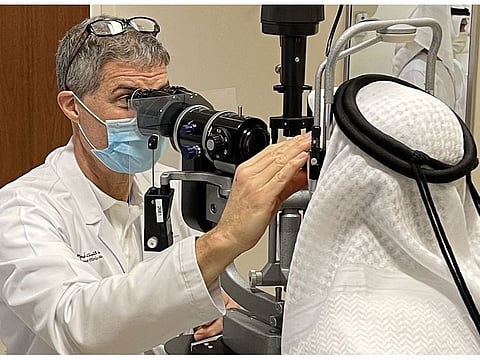Cleveland Clinic Abu Dhabi performs UAE’s first artificial corneal transplant
Sight-restoring procedure helps patients with advanced corneal or ocular surface disease

Abu Dhabi: The UAE’s first artificial corneal transplant has been successfully performed at the Cleveland Clinic Abu Dhabi (CCAD).
In a statement, the Abu Dhabi Government’s Mubadala-owned hospital said on Monday that doctors now expect to perform several artificial corneal transplants each year. The sight-restoring procedure takes a little over an hour, and is usually treated as a day case, with patients able to be discharged on the same day.
Cornea transplants
The cornea is the clear, dome-shaped window that protects the eye, and helps the lens focus light. This vital part of the eye can become clouded or damaged due to eye disease or injury, causing vision loss and even blindness. To overcome this, corneal transplants replace the damaged cornea with tissue from a donor, restoring or improving vision significantly.
Why artificial corneas
While corneal transplants from a human donor have been used for a number of years, some patients with severe corneal or ocular surface disease are not candidates for this traditional approach, since a transplanted cornea would quickly succumb to disease or be rejected, offering no improvement for their condition. The introduction of artificial corneal transplants, known as keratoprostheses, offers these patients fresh hope of restoring their vision. Made of modern materials rather than donor tissue, the artificial cornea cannot be affected by clouding or rejection.
“Artificial corneal transplants are designed for people whose eye disease is so advanced, they would not be a candidate for a regular transplant. Using an artificial cornea means the body cannot attack or reject the transplant. The centre of the eye remains clear, giving the patient a new window to the world,” said Dr. Samuel Navon, department chair of anterior segment, cornea and refractive disorders at CCAD’s Eye Institute.
Procedure
During the operation, surgeons remove the patient’s diseased cornea and replace it with a three-part prosthetic composed of a titanium backplate, a clear artificial cornea and a ring of donor tissue to help secure it in place. As the human tissue only surrounds the new, artificial cornea, even if it is rejected by the body, it does not impact the patient’s restored vision. “We give patients a new cornea that won’t be rejected by the body. Surrounding that, we use human donor tissue that we almost expect to be rejected. However, this has no impact on the patient or their vision, it is simply there to make sure the new cornea stays in place,” Dr. Navon explained.
Cornea damage
Conditions that can cause a patient to require conventional cornea transplants include infections, injuries and keratoconus, a condition that is more common in the Gulf region than many other parts of the world. However, when traditional transplants have failed, or if the ocular surface is also damaged, studies have shown better success with artificial cornea transplants.
Following cornea transplant surgery, regular postoperative visits are required to check for possible complications and monitor the overall health of the eye.
Transplant centre
Last week, CCAD — the UAE’s only multi-organt transplant centre — also announced the UAE’s first ever successful pancreas transplant. The pancreas was transplanted as part of a dual transplant procedure on a diabetic Emirati patient, who also received a new kidney at the same time.
The hospital has been carrying out transplant procedures since 2017, including transplants of heart, liver, lung and kidney before 2020.
Sign up for the Daily Briefing
Get the latest news and updates straight to your inbox







